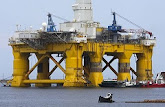The number of rigs drilling for oil fell to 600 in the week ending on February 24, down from a recent peak of 627 in the week ending on December 02, 2022 oilfield services company Baker Hughes found.
The rig count has declined in five of the eight most recent weeks and is at the lowest level since the start of July 2022.
The acceleration of drilling activity that started in August 2020 after the first wave of the pandemic appears to have paused or possibly ended.
Over the last three decades, changes in the rig count have generally followed changes in front-month WTI futures prices with an average lag of about 4-5 months (roughly 19 weeks).
When
prices rise, delays reflect the time needed to confirm a change in price level
is persistent rather than temporary, contract extra rigs, move them to the
drill site, erect the equipment, and begin boring.
When prices fall, the lag reflects time needed to confirm the trend, finish part-drilled wells, drill wells already under contract, and idle unneeded rigs.
The number of rigs drilling for oil peaked in late November 2022, roughly 25 weeks after prices peaked, slightly longer than average.
Since June 2022, prices have generally retreated, which has been reflected in a gradual turnover in drilling activity rates.
Prices are roughly 15% below year-ago levels and still trending lower, implying drilling is likely to continue falling through end of June 2023.
Once drilling is finished, there is a further delay of six months on average for casing, pressure pumping, installation of surface equipment, flow testing, linking up to the pipeline network and entering commercial production.
The current slowdown in drilling is therefore likely to reduce production growth through the end of 2023 and probably into 2024.
The Energy Information Administration (EIA) forecasts US production will be only 340,000 barrels per day (2.7%) higher in December 2023 than it was in December 2022.
If this forecast is realized, growth will have halved from 660,000 barrels per day (5.8%) in December 2022 compared with December 2021.
Growth would be just one-sixth of what it was at the height of the second shale drilling boom in 2018, marking the end of the shale revolution.
Slower growth in US production will reduce any accumulation of crude inventories, even if the global economy slows this year, and restrict the potential for non-inflationary growth in the remainder of 2023 and 2024.
